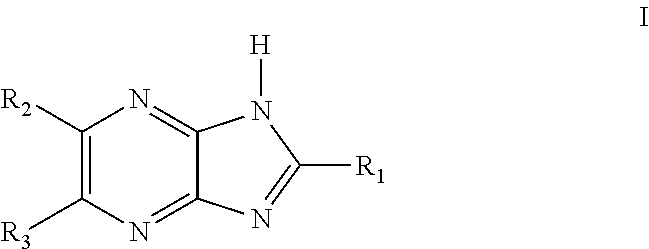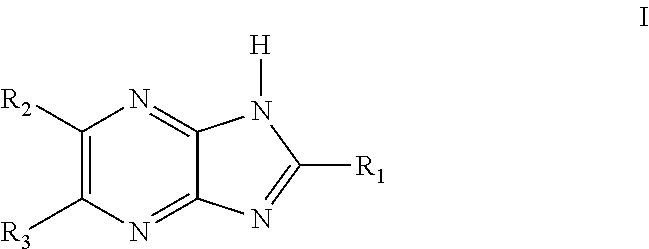Organic solderability preservative and method
a preservative and organic technology, applied in the direction of non-metallic protective coating application, coating, luminescent composition, etc., can solve the problems of low protectiveness, poor stability at higher temperatures, deterioration of solderability, etc., to retain the solderability of copper and copper alloy surfaces, enhance the final protective coating, and improve the effect of anti-corrosion properties and thermal stability
- Summary
- Abstract
- Description
- Claims
- Application Information
AI Technical Summary
Benefits of technology
Problems solved by technology
Method used
Image
Examples
example 1
[0042]1-H-imidazole[4,5-b]pyrazine compound was prepared by mixing two grams of 2,3-diaminopyrazine and 10 mL of triethyl orthoformate then refluxing at 140-145° C. for 2 hours under nitrogen. The reaction mixture was cooled, filtered and washed with hexane. The solid obtained was dissolved in 10 mL of 10% sodium hydroxide solution at 100° C. for 10 minutes and filtered while hot. 10 mL of acetic acid was added to the filtrate which was then stored overnight at room temperature. Light brown crystals were collected by filtration with a yield of 75% or 1.64 g. See J. Am. Chem. Soc., 78, 242-244, 1956. The product was confirmed to be 1-H-imidazole[4,5-b]pyrazine recrystallized from acetic acid using 1H-NMR (Brucker ADVANCE III 400 MHz) and mass spectrometry (Thermo Finnigan MAT 95XL).
example 2
[0043]An OSP solution was made as described below.
TABLE 1ChemicalsAmountsAcetic acidAdjust pH1-H-imidazole[4,5-b]pyrazine0.0413 mol / LCopper (II) chloride (dihydrate)0.0016 mol / LBath pH2.5
[0044]The working bath which had 5 g / L 1-H-imidazole[4,5-b]pyrazine and 100 ppm copper ions was prepared as follows:[0045]1. 1 g 1-H-imidazole[4,5-b]pyrazine prepared according to the method described in Example 1 was dissolved in 250 mL beaker with 100 ml RO water;[0046]2. The solution was stirred until the solid dissolved (mixture A);[0047]3. The pH of mixture A was adjusted to 2.5 with 50% acetic acid;[0048]4. A 10 g / L copper (II) chloride dihydrate solution was prepared in a volumetric flask and then 2 mL of this copper chloride solution was transferred into mixture A; and[0049]5. Sufficient amount of RO water was added to mixture A to bring the volume to 200 mL.
[0050]Three FR-4 copper clad laminates obtained from Fastprint China were treated with the OSP bath and according to the process disclo...
example 3
[0053]The process described in Example 2 was repeated except the OSPs used were 0.04 mol / L of 2,4-dipheyl-1H-imidazole formulation. Three OSP samples were tested.
[0054]One sample did not undergo reflow and had a continuous OSP thickness of 600 nm and was uniform. The second sample also had a continuous and uniform OSP thickness of 600 nm and the third sample had a continuous and uniform layer of 200 nm. After 5× reflow cycles the thickness of the second OSP sample was 500 nm, thus the OSP thickness did not significantly change from the laminate which was not reflowed; however, delamination of the OSP coating was observed. The third treated laminate after 11× reflow cycles had an OSP thickness of 170 nm which was continuous but not uniform. In addition, delamination of the OSP coating was observed.
PUM
| Property | Measurement | Unit |
|---|---|---|
| thickness | aaaaa | aaaaa |
| thickness | aaaaa | aaaaa |
| decomposition temperature | aaaaa | aaaaa |
Abstract
Description
Claims
Application Information
 Login to View More
Login to View More - Generate Ideas
- Intellectual Property
- Life Sciences
- Materials
- Tech Scout
- Unparalleled Data Quality
- Higher Quality Content
- 60% Fewer Hallucinations
Browse by: Latest US Patents, China's latest patents, Technical Efficacy Thesaurus, Application Domain, Technology Topic, Popular Technical Reports.
© 2025 PatSnap. All rights reserved.Legal|Privacy policy|Modern Slavery Act Transparency Statement|Sitemap|About US| Contact US: help@patsnap.com



